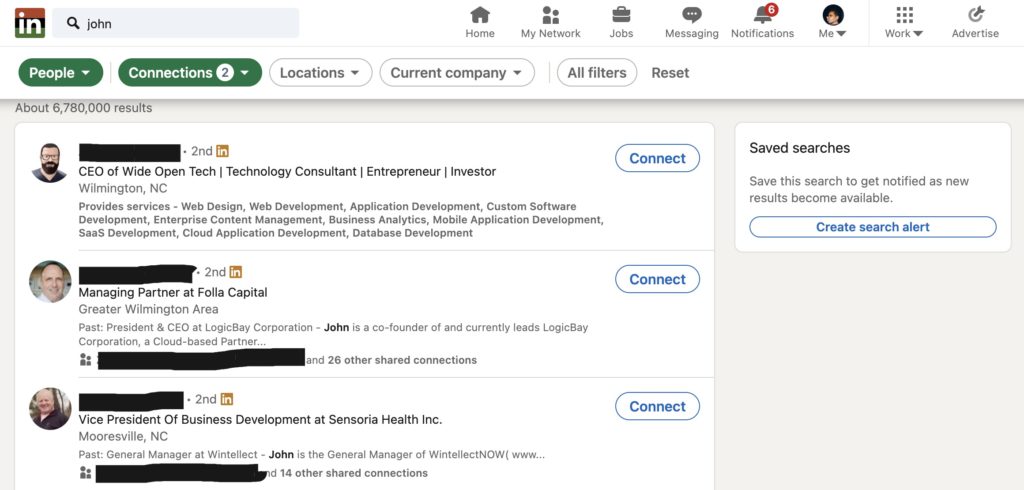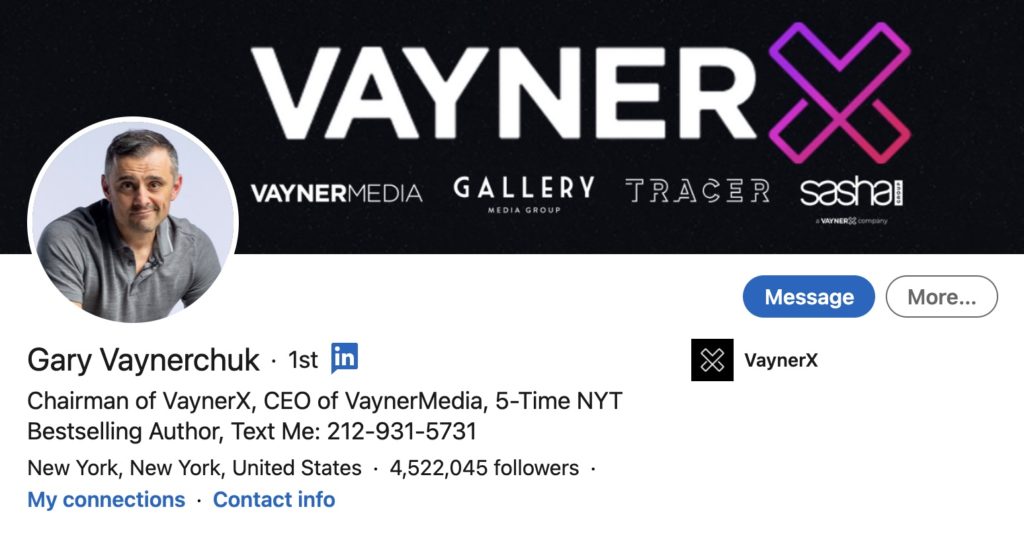Top B2B Growth Hacks on LinkedIn [2021 Update]
LinkedIn is the number-one platform for B2B marketers, and for good reason: unlike on other social networks, people are browsing LinkedIn with the intention to hustle. They’re in the mindset to grow as professionals and build their business. This means you don’t have to cut through the noise of cat photos and dance videos!
However, LinkedIn doesn’t exactly make it easy to reach your dream prospects. Let’s take a look at how the best growth hackers turn LinkedIn from a job search and resumé hub into a powerful B2B outreach platform.

Growth Hack #1: Scour Groups to Find Ideal Prospects on LinkedIn
Facebook groups are a great opportunity for B2B marketing. They typically revolve around niche topics and attract members who are very invested in those topics. When you find a Facebook group that mirrors your target prospects’ key interests, you can usually be confident that those members are qualified leads.
Unfortunately, pitching yourself in Facebook groups is often a big no-no. And Facebook makes it difficult to contact people you’re not connected with. Any cold messages typically go into the dreaded “Message Requests” folder, and many people won’t accept friend requests from people they don’t know.
LinkedIn is different. It’s designed for cold connections, and people are more likely to open messages from people they don’t know. Plus, they’ll see your requests as soon as they log in. The solution, then, is to translate your target Facebook Group members into LinkedIn connections.
Here’s how to do it:
Step 1: Find a Facebook group where your target prospects hang out.
This could be a professional community, a networking group for people in your target industry, a group for sharing advice on topics that your audience cares about, etc. Tip: Search relevant keywords in Facebook’s search bar and click the “Groups” tab to narrow your results.
Step 2: Use a tool such as Phantombuster to scrape the names of the group’s members and convert them into LinkedIn profile URLs.
This method isn’t foolproof (some people will have different names on Facebook and LinkedIn) but is a good way to generate a list of potential leads. And it’s much faster than manually typing each group member’s name into the LinkedIn search bar. Follow these steps to make it happen:
- Copy the URL of the Facebook group(s) whose members you want to target.
- Create a Phantombuster account and install the Chrome extension.
- Visit Phantombuster’s Facebook Group Extractor and click “Use this Phantom.”
- Select “Get cookies from Facebook.”
- Paste the Facebook group URL into the field named “Facebook Group URL/Spreadsheet URL.”
- Name your action and click “Launch.”
- Once Phantombuster does its thing, click “Download/Get Link.”
- Go to Phantombuster’s LinkedIn Profile URL Finder and click “Use this Phantom.”
- Import the data you got in #7 above into a Google spreadsheet.
- Copy and paste the Google sheet’s URL into Phantombuster.
- Name your action and click “Launch.”
- Download your list of LinkedIn profiles to target!
Step 3. Craft a LinkedIn messaging campaign to send targeted messages to those LinkedIn users.
You can use a tool such as Expandi to automate your messaging and save valuable time. This sends targeted connection requests to your list of LinkedIn prospects, automatically sending follow-up messages depending on how the lead responds. Obviously, this spares you the tedium of constantly monitoring and responding to hundreds of messages.
Here’s how to set it up.
- Create an Expandi account.
- Set up a “Connector Campaign” and fill in the form with your outreach content and follow-up messages. You can use placeholders for your leads’ first name and other details so that Expandi can customize each message.
- Configure your time delta so that messages arrive at the right time.
- Save your campaign with a name you won’t forget.
- Visit “Search” in the left menu and click “Start New Search.”
- Name your search and click “Import contacts from CSV.”
- Upload the spreadsheet you created in Step 2 into Expandi.
- Click “Search” so that Expandi can look up all the leads in your file.
- Click on the search in the right column and select the people you want to message.
- Click “Assign to campaign” and choose your Connector Campaign.
- Click on “Add select contacts to campaign.”
- Expandi does its thing!
When writing your outreach message, tap into the key topic that defines the Facebook group, e.g. “I saw that you and I share an interest in [topic X]! Would love to connect and pick your brain sometime.” Then, ask to connect. Because you’re approaching them as an informed, authentic person, they’re more likely to respond.

Growth Hack #2: Dig Into Shared LinkedIn Connections
Your ideal prospects likely receive dozens of connection requests, and most are going to ignore anyone whose name doesn’t ring a bell. However, if they see that you have a connection in common, they’ll be more likely to accept your request. So, start by engaging with people in your target prospect’s network.
Comment on their posts, leave compliments, and start a discussion. Keep the focus on others, not yourself. LinkedIn has a tendency to encourage self-serving content, so by acknowledging others’ achievements and content, you’ll stand out from 99% of LinkedIn users.
Send a connection request when the time is right, then wait until you have at least one shared connection with your main prospect before engaging with them.
Growth Hack #3: Connect With People Who Liked Your Prospect’s LinkedIn Posts
Now that LinkedIn is also a publishing platform, it’s a great place to fire up your content marketing as well. However, you can do much more than publish your own great content. Check out what your target prospect is publishing and start making connections with people who engage with their content.
Look for a post with great engagement. Then, use a tool such as Phantombuster’s LinkedIn Post Commenters to make a list of the people who engaged with the post. You can then reach out to them with an automated Expandi campaign, further building up your shared network with your prospect.

Growth Hack #4: Tap Into LinkedIn Influencers’ Audience
You can also generate a list of target prospects right there on LinkedIn. Searching for people’s job title and location will only get you so far. To find people who would probably like to hear from you, search for top-performing content on your key topics. Identify influencers who have a large following, then use a tool like Expandi to generate a list of their followers (as well as everyone who engaged with their popular posts).
You can then (a) reach out to those prospects and (b) create content that mirrors their interests. You know they are qualified leads because they’re already interested in the topic or problem that the influencer published about. Follow the same outreach approach described above: tap into a shared interest and tell them you’d like to connect.
Growth Hack #5: Turn Your Team Members Into Brand Ambassadors
Like any social network, LinkedIn has an algorithm that sends popular posts to the top of the feed. It’s constantly measuring who engages with what content and where they work. So, if you want to forge a stronger connection with your prospects, give them a boost. In addition to liking and commenting on their posts, have key members of your team do so as well. They should also engage with content made by your prospect’s LinkedIn connections.
Only one member of your team should send the connection requests and cold messages — otherwise, it can seem a little creepy and spammy. But by having your team engage with posts made by people in your prospect’s network, you show LinkedIn’s algorithm that you’re interested in each other’s content. This can help your posts and requests gain more attention from them.
Wrapping Up
These “growth hacks” are really just a way of forging more connections. That’s the lifeblood of LinkedIn: it builds trust and name recognition, which can help you get in the door. Automated tools such as Phantombuster and Expandi cut down on the time required to process names and find profile URLs. The rest is up to you! Be strategic and keep the focus on your prospects and their network. This approach will help you stand out from the crowd.
We get it. It can be hard to read a long article like this, retain all the information, and then apply it to your business. If you find yourself in this situation, click here to hop on a call with us. We’ll be able to talk about the details of your business and give you some advice on where to take your content and more.
Be sure to join our mailing list to be the first to know when we drop more educational content like this!
